There are two familiar narratives about fostering scalability in blockchain technology. We have layer 2 scalability to begin with. Layer 2 protocols argue that a modular architecture enables layers to focus on critical areas individually, which results in better overall performance than a monolithic design.
Many alternate layer 1s argue against the above narrative. Some have proposed novel scalability solutions and harbour thriving ecosystems in their own right. There were two such blockchain projects going head to head by 2022. The highly revered Solana protocol achieved sub-second scalability with its Proof of History consensus engine. A February 2022 Decrypt piece spoke about another up-and-coming layer 1 protocol that set out to beat Solana at its game. The Aptos blockchain, popularly dubbed the “Solana Killer” by crypto degens, branched off Meta (formerly Facebook) and made headlines for its near-instant transaction times.
This article will review the Aptos Network, whose whitepaper claims it has the most efficient parallel execution blockchain design to date, so let's see what the hype is all about!
Aptos Network Overview
The Aptos blockchain is a layer 1, non-EVM network delivering high scalability. It adopts the AptosBFT, a Proof of Stake BFT (Byzantine Fault Tolerant) consensus engine. Aptos is built on the Move programming language, initially developed for Meta’s Diem project. The rebranded project Aptos Network has raised over $350 million through multiple funding rounds led by a16z, Jump Crypto, and Circle Ventures.
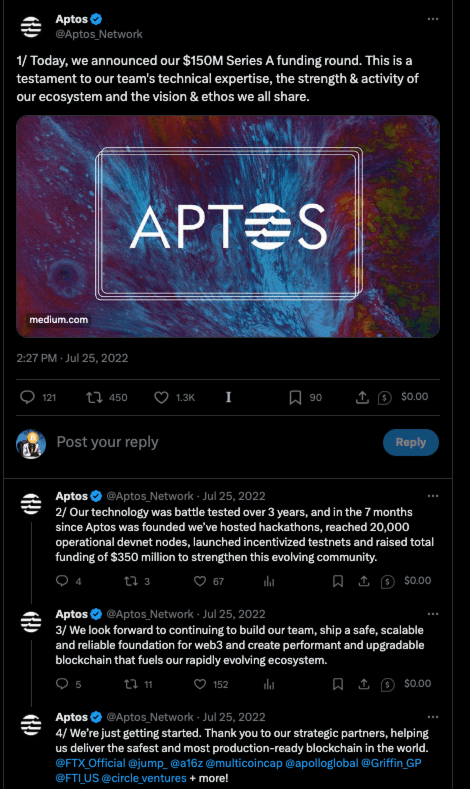
Here are some standout features the Aptos Network offers:
- Move programming language – The Aptos blockchain supports the Move language natively. The Aptos blockchain state is based on the principles defined in the Move object model. With Move, the Aptos network enables fast execution and swift and secure auditability.
- The Aptos blockchain can batch, pipeline, and parallelize transaction processing to offer high throughput and low latency between validators.
- The parallel transaction processing on Aptos can also process arbitrarily complex transactions and does not break transaction atomicity.
- Aptos offers on-chain key management techniques and transaction pre-signing summaries.
- A modular design approach enables easy module upgradeability and configurability. Auditors can model threats at the component level, allowing for more granular testing of smart contracts.
- The Aptos blockchain can scale horizontally with sharding.
Aptos Network History
The work on the Aptos Network did not start from scratch. It is a culmination of several years of research and development under Meta, where it underwent multiple rounds of rebranding and goal restructuring.
Although the Aptos blockchain network mainnet went live in October 2022, its roots lead back to Meta’s blockchain initiatives in 2018. Here is a recap of the events leading to the foundation of Aptos:
- May 2018 – Facebook’s blockchain initiative launch: David Marcus, the social media giant’s vice president for its Messenger chatting app, announced the company’s new blockchain initiative under his leadership on his Facebook page.
"After nearly four unbelievably rewarding years leading Messenger, I have decided it was time for me to take on a new challenge. I'm setting up a small group to explore how to best leverage blockchain across Facebook, starting from scratch," – David Marcus.
- June 2019 – Announcement of Project Libra: Facebook unveiled Project Libra in association with Andreessen Horowitz, Visa, and Uber. The vision behind Libra was to support the global financial system with blockchain technology. The project featured the Libra stablecoin tied to a basket of globally transacted fiat currencies, balanced by the Libra Association, like the dollar, pound, euro, Swiss franc, and yen.
- Move programming language: The Libra Association promoted an open-source blockchain development platform powered by their Move programming language, designed for smart contract development in the Libra ecosystem.
- October 2019 – Exit of crucial members from Libra Association: Following intense regularity scrutiny, critical partners like PayPal, Mastercard, and Visa pulled out of project Libra. Regulators cited KYC/AML-related issues with Libra, its potential to disrupt financial markets and the US Dollar reserve currency status.
- April 2020 – Rebranding and strategy shift: Regulatory hurdles forced Libra to rebrand and scale back. Instead of a global stablecoin, the team continued to work on the Move language to develop a digital payments network.
- December 2020 – Transition to Diem: The rebranding to Diem represented a fresh start for the project. Move continued as a core component of the project and the underlying blockchain network.
- 2021 – Regulatory challenges continue: Despite the rebranding, Diem continued to struggle with the regulators, who were concerned about a cryptocurrency run on the network and still demanded stricter KYC-related compliance from the network users. Failing to take off, Diem decides to sell its assets, including the Move language.
- 2022 – Foundation of Aptos Labs: Former Diem developers Mo Shaikh and Avery Ching established Aptos Labs. They announce the Aptos Network, which utilizes the Move programming language developed for Diem. Aptos focuses on scalability, security, and usability, aiming to address some of the limitations of existing blockchain platforms.

Aptos in Recent History
With the final scale back to focusing on the scalability capabilities of the Move language, the Aptos blockchain finally found some success following its last rebranding. It has since made several breakthroughs in blockchain technology and established renowned partnerships:
- November 2022 – Partnership with Google Cloud: In an announcement, Aptos Labs shared that Google Cloud is running a validator on Aptos three weeks after its mainnet launch. The partnership entailed signing Google Cloud for Apto's internal development operations.
- March 2023 – Aptos Software Development Kit (SDK): The Aptos SDK was built to help Web3 game developers on Unity enable blockchain-based interoperability and transparency.
- May 2023 – Improving scalability with Narwhal: Aptos Labs unveiled the Quorum Store, the first implementation of the Narwhal mempool protocol. Quorum Store decoupled transaction data broadcasting and ordering, allowing validators to sync data without leaders in parallel, improving network latency.
- August 2023 – Aptos and Microsoft partnership: Aptos co-founder Mo Shaikh, revealed the integration of Microsoft’s Azure OpenAI Service into the Aptos Network, which they claim will make it easier for people to explore Web3 and build the next phase of the internet.
- October 2023 – Graffio makes strides in adoption: Graffio is the first social application on Aptos. The team claims in an announcement that the Dapp witnessed about 600K registrations across 173 countries in just 24 hours.
Move Programming Language
Move, a smart contract programming language developed for the Aptos blockchain, emphasizes safety and flexibility. Drawing inspiration from Rust, Move makes data ownership explicit through concepts like linear types. The Move object model is pivotal in representing Aptos' ledger state, while the Move code, comprising modules, dictates the rules for state transitions. These modules are essential for various actions, such as publishing new modules, upgrading existing ones, executing module entry functions, or running scripts interacting with module interfaces.
The Move ecosystem features a compiler, a virtual machine, and extensive developer tools. Its design focuses on resource scarcity, preservation, and access control. This approach ensures resources like coins are managed securely, preventing issues like double-spending. Move modules meticulously define the lifecycle, storage, and access patterns of resources, enhancing overall network security.
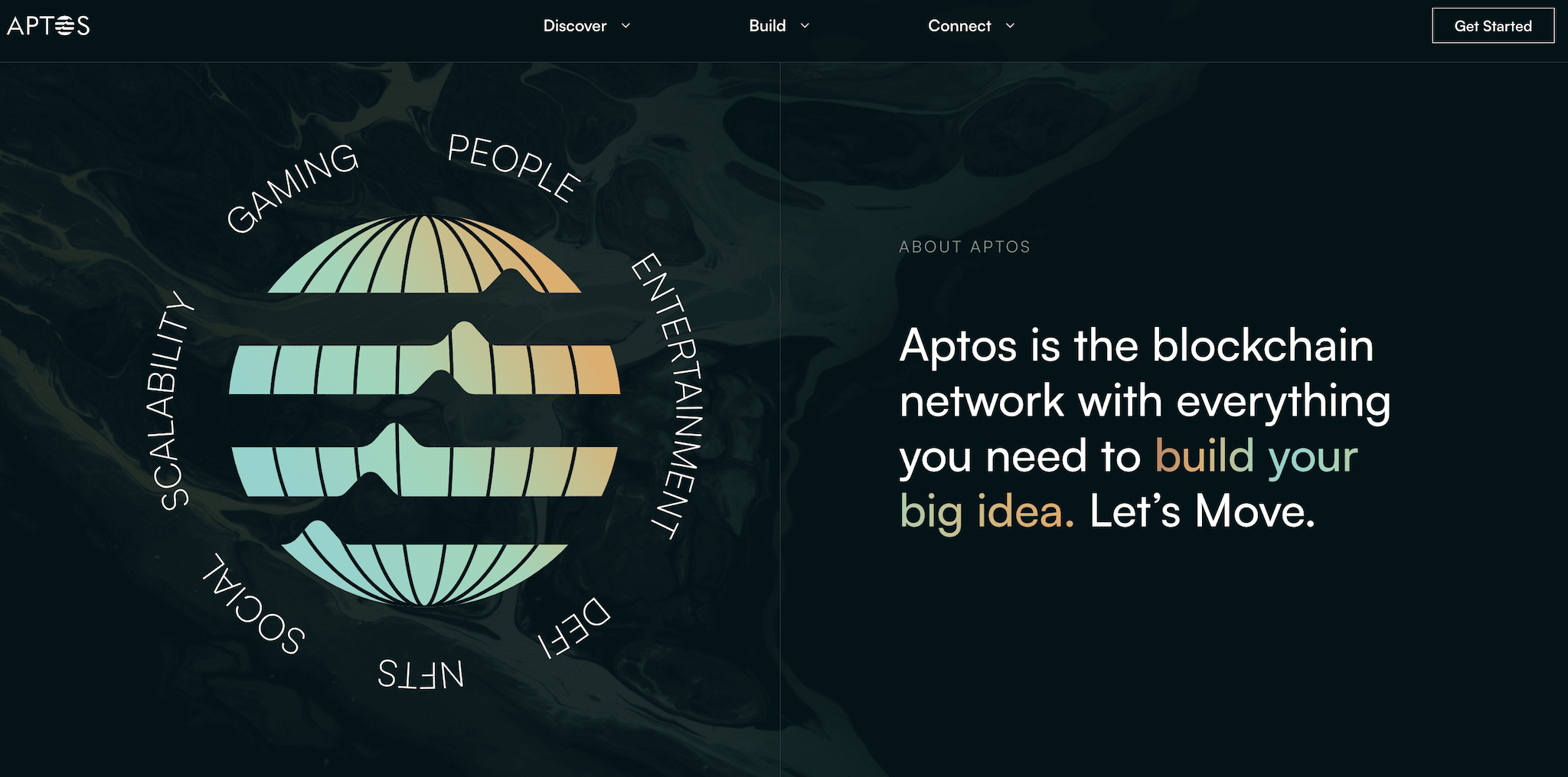
Move's architecture also plays a critical role in the functionality of the Aptos blockchain, including managing user accounts, their content, and the on-chain network configuration, such as validator sets and staking properties. The language's support for module upgradeability and its programmable nature facilitate seamless updates and upgrades to the Aptos blockchain, enhancing its efficiency and zero-downtime operations.
Significantly, the Aptos team has expanded Move's capabilities to cater to a broader range of web3 applications, including supporting NFTs and DAOs through enhanced resource control and integrating large-scale datasets within single accounts. The blockchain's fine-grained resource control not only aids in execution parallelization but also ensures a near-fixed cost for data access and mutation. Moreover, Aptos enables shared or autonomous accounts, fully represented on-chain, allowing for intricate DAO operations and diverse resource collections.
Aptos User Experience and Safety
The Aptos Network offers several user safety and accessibility features to help reduce the anxiety behind operating with the immutability of on-chain transactions. Here are some essential safety features provided in the Aptos Network:
- Transaction viability protection: After a user signs a transaction, it must successfully commit to the blockchain with the correct sequence number, within the transaction expiration time, and with the designated chain identifier. The transaction must meet all these prerequisites to commit to the blockchain.
- Move-based key management: Aptos supports several on-chain key management techniques. These include enabling the validator to rotate private keys and delegate the ability to rotate keys to one or more custodians or other trusted entities. Move also supports programmable key rotation with the help of move modules.
- Pre-signing transaction transparency: Aptos provides a transaction pre-execution measure that describes to the user the outcome of the transactions before they sign so they can assess if the result aligns with their intentions.
- Practical light client protocols: To prevent API providers from returning incorrect or malicious data, Aptos provides state proofs and light client verification protocols that wallets and clients can use to verify the validity of data an untrusted third party offers.
Aptos Network Performance Innovations
The Aptos blockchain propagates in various stages. Stages like transaction ordering, batching, and execution are entirely independent of one another and can run in parallel. The modularization of the blockchain process provides significant performance benefits like improving throughput, increasing concurrency and reducing engineering complexity. Every stage on Aptos is individually parallelizable. Here is such an instance:
- Persisted and valid transactions have a high likelihood of validators including them in the block. Clients are notified when such transactions comprise a particular transaction batch.
- Rather than waiting for validators to complete execution remotely, clients can be informed when such transactions are ordered. Then, they can execute them locally and reduce the latency of determining transaction outputs.
- Clients can elect to wait for certified transaction execution by the validators and perform state synchronization on the attested results.
A modular design supports faster development, as developers can target changes to individual modules instead of upgrading the whole architecture.
Batch Processing
Batch processing is an essential efficiency optimization technique used by the Aptos blockchain validators. Transactions enter the blockchain via validators. Each validator propagates the transaction data to every other validator so that they have adequate data available to perform security checks in the consensus process, which is known as transaction dissemination.
In the Aptos Network, every validator groups the transactions it wants to include in the blockchain into batches during transaction dissemination. The batches are later combined into blocks during consensus. To enable opportunities to reorder transactions and reduce the number of operations, the execution, storage, and ledger certification also work in batches.
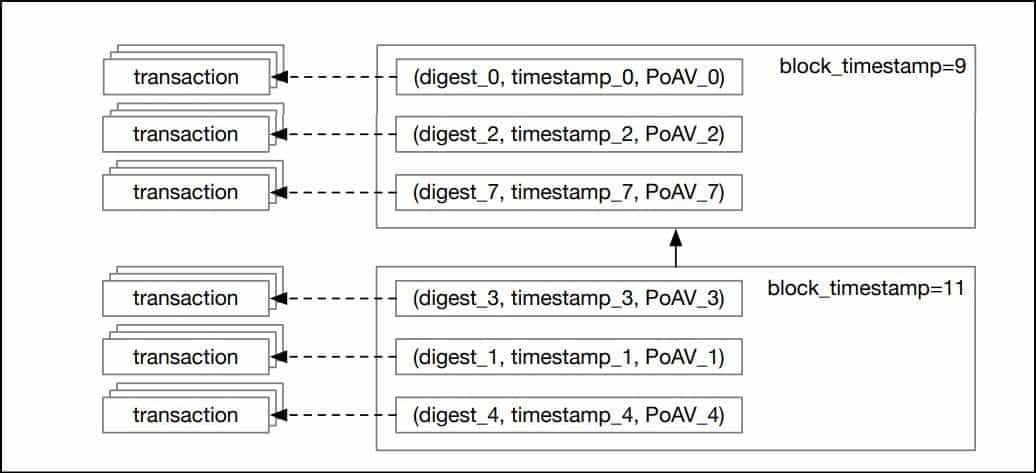
Continuous Transaction Dissemination
In a typical block propagation process like Ethereum, transaction dissemination is a part of the consensus process, which means that consensus does not begin until all the validators have received the minimum amount of transaction data to participate in consensus. Propagating this amount of data to all the validator nodes takes time, the Aptos Network functions a little differently.
The transaction dissemination process is decoupled from consensus in the Aptos Network. Validators disseminate transaction batches to each other continuously to ensure the network is always running at peak capacity. The validators sign the batches as they propagate them across the network.

Once a majority of honest validators have added their signatures to a particular batch, it is known to have formed Proof of Availability (PoAv), a guarantee that the batch of transactions will be available at the time of execution, which comes after batch ordering and consensus.
Aptos Blockchain Block Data Ordering
Consensus is the most time-intensive task in a typical Proof of Stake blockchain. The Aptos blockchain reduces the time invested in the consensus process by decoupling every other task that does not involve validator agreements, like transaction dissemination, transaction execution, storage, and ledger certification from consensus. By decoupling these processes, the consensus consumes very low bandwidth, which makes it fast.
The Aptos Blockchain uses the DiemBFTv4 consensus engine. Here are some of its notable characteristics:
- Dynamically adjusts to faulty validators with a leader rotation mechanism that promotes participating validators and demotes those that are not participating.
- Promoting functioning validators improves network performance, provides infrastructure for appropriate incentives, and minimizes the impact of failed validators on throughput and latency.
- It guarantees that the blockchain remains functional and safe until the honest validator stake is at least more than three times the stake of faulty validators.
Parallel Transaction Execution
In the previous section, we learned how the Aptos blockchain disseminates the transaction batches throughout the network and later orders them efficiently. Once ordered, any validator, full node, or client can execute those transactions.
We also learned that the Aptos Network does not wait for all the validators to receive the complete transaction data to improve consensus latency. Therefore, there may be an instance where a particular node might not have access to the required data to execute the transaction. Since transaction dissemination is continuous, additional validators will eventually receive the transaction batches over time.
In case an honest validator has not received the data for the ordered transactions in time for its execution, it can download them from other participating honest validators. The consensus ensures that at least 2f + 1 stake-weighed validators (where ‘f’ represents faulty validators) can access the required transaction data.
One of the Aptos blockchain's standout features is efficient transaction parallel execution, which it advances from its data model and the execution engine.
Parallel Data Model
The ethos of parallel execution is that the transactions that do not affect each other’s state can be executed in parallel. For instance, a transaction between Bob and Bill and Jack and Jill are mutually exclusive. The accounts and the underlying data do not overlap and can be executed by the network in parallel. The Aptos blockchain design can support parallel execution even when the transactions modify the same set of on-chain values. It processes all transactions in parallel and creates an updating sequence for the repeating on-chain values. Instead of updating the values after every transaction, it applies the entire sequence at once, saving processing time.
Parallel Execution Engine
The Aptos blockchain has deployed the Block-STM parallel execution engine to execute transactions in parallel. In blockchain, parallel execution can get tricky. Conflicts arise when two transactions initially thought mutually exclusive by the execution engine turn out otherwise.
Block-STM executes transactions in parallel and validates them post-execution. Unsuccessful validation leads to conflicts, which triggers re-executions. Therefore, the more a parallel execution engine can minimize conflicts, the more efficient it gets at executing transactions in parallel.
In the Aptos whitepaper, the authors claim that Block-STM was 8-16 times faster than sequential execution engines in simulations run by their team. They also claim that their engine can extract parallelism from any workload without additional inputs from the user, a quality that other engines in the market lack.
After the block data ordering step, the Block-STM engine may reorder transactions across one or more blocks to optimize concurrency for parallel execution with the only requirement that the reordering must be deterministic across all honest validators. The whitepaper also claims that this ordering discourages minimal extractable value (MEV) techniques.

State Synchronization
State synchronization refers to a light client, validator, or full node updating its local history to the current state of a blockchain. The network offers a customizable state synchronization protocol to disseminate, verify, and record blockchain data to provide a high throughput, low latency system for all participants in the Aptos ecosystem.
The scope of state synchronization may differ among blockchain participants. For example, a full node might archive the entire blockchain history since the genesis block, whereas a light node might limit itself to block headers.
Aptos allows flexible state synchronization strategies, including processing all transactions since the genesis or skipping the history to record only the latest state with the help of waypoints. Aptos allows participants to configure the amount and age of data to fetch, process, and retain.
Governance
The Aptos blockchain follows a phased approach for major changes involving proposal, implementation, testing, and deployment, with feedback encouraged. The deployment includes a two-step process ensuring backward compatibility and spans multiple days for global operators. New features activate synchronously based on agreed-upon block height or epoch change, with emergency conditions allowing manual changes or, in extreme cases, a hard fork.
Unlike other blockchains, Aptos stores its configuration on-chain, facilitating seamless and instant upgrades. On-chain governance enables token holders to vote on upgrades, providing flexibility. This public and verifiable voting process supports non-binary outcomes without software deployment. On-chain governance is applied across the upgrade process, including voting on signature scheme transitions, release implementation, validator upgrades, and activation through on-chain configuration.
As an open-source platform, Aptos relies on community feedback and on-chain governance for effective management. While off-chain upgrades may occur under specific conditions, efforts are made to minimize their frequency over time.
Over time, on-chain governance can be deployed across the entire upgrade management process. The whitepaper provides the following example:
- Token holders vote on-chain about transitioning to a new quantum-resistant signature scheme.
- Developers implement and verify the new signature scheme and create a new software release.
- Validators upgrade their software to the new release.
- Token holders vote on-chain to enable the new signature scheme, the on-chain configuration is updated, and the change takes effect.
Aptos Network Consensus
The Aptos Network consensus works on a consensus algorithm known as AptosBFT. It is a Byzantine fault-tolerant Proof of Stake consensus algorithm that can tolerate up to one-third of dishonest validators. So, for every ‘f’ number of traitors, the network needs at least 3f + 1 honest validators to function correctly.
Participants stake APT tokens to join the consensus process. One may participate in consensus as a full node by fulfilling the network’s staking requirements or delegate their tokens to other full nodes to participate passively. There are three staking-based roles in the Aptos network:
- Owner: These are the accounts that own APT tokens. They can stake their tokens directly or delegate them to other participants.
- Operators: They are full node validators that participate in the PoS consensus. Operators may stake their APT tokens or have owners delegate their tokens. Owners retain the right to spend, stake, or unstake their delegated tokens.
- Voters: These are the entities that participate in Aptos governance proposals. They function similarly as operators.
The network selects a leader that pools all the messages and creates the block to reduce the number of messages that validators need to verify during consensus. Here’s the block validation process:
- A leader is selected by the network using a deterministic formula based on the validator’s on-chain reputation and stake.
- The leader sends a proposal containing the collected quorum votes and its proposed order of transactions for the new block.
- All the validators vote on the proposal. If they reach a consensus, the block is finalized, and the leader is rewarded.
- The above process repeats for the next block.
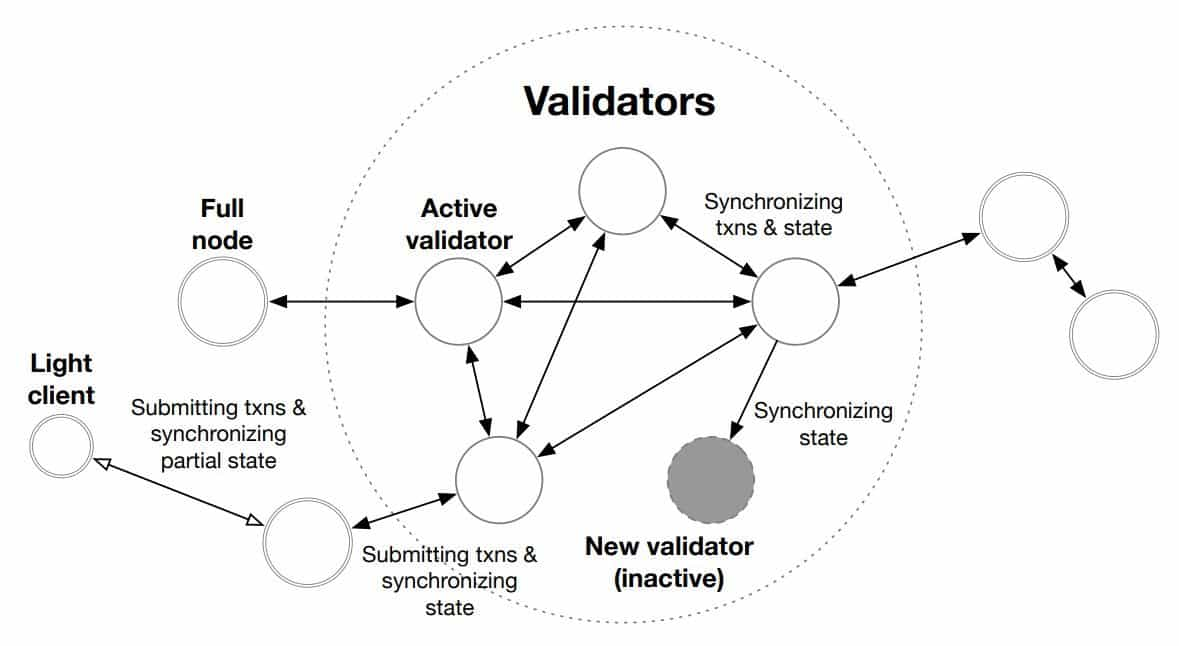
Aptos Node Requirements
A full node validator needs to stake at least one million and up to 50 million APT tokens to participate in consensus. The rewards are paid at the end of every epoch and are proportional to the amount of APT staked by the validator.
Hardware requirements
The following hardware resources are recommended to run an Aptos validator node and validator full node :
- CPU: 8 cores, 16 threads; 2.8GHz, or faster; Intel Xeon Skylake or newer
- Memory: 32GB RAM
- Storage: 2T SSD with at least 40K IOPS and 200MiB/s bandwidth
- Networking bandwidth: 1Gbps
In contrast, here are the full node requirements on the Ethereum network, after it transitioned to Proof of Stake consensus:
- Stake amount: 32 ETH
- A modern CPU (at least a dual-core CPU, but a low-TDP desktop part or a mobile part like the 5500U is recommended)
- 32 GB of memory (you can start with one 16 GB stick and add another later)
- 2 TB quality SSD
The only notable difference between the hardware requirements of Ethereum and Aptos is that the latter demands a more powerful CPU and a high bandwidth internet connection. While the CPU requirements in Aptos are high, it is on par with most modern CPUs, making it easily acquirable.
While the hardware requirements are comparable, staking requirements are not. Based on ETH and APT prices when writing this review, a full node on Ethereum had staked roughly $62,000 worth of ETH on the network. At the same time, an Aptos validator needs to stake about $7 million to qualify for the validator pool, which is significantly higher than in Ethereum. Quite notably, Aptos supports native delegation, while Ethereum does not.
The APT Token
APT is the native token in the Aptos ecosystem. It is used to pay for paying transaction gas fees and for participating in the network via staking. The Aptos mainnet went live on October 12th, 2022, with an initial supply of one billion APT tokens. The tokens are divided among ecosystem contributors as follows:
- Community – 51.02%
- Core contributors – 19%
- The Aptos Foundation – 16.5%
- Investors – 13.48%
The Aptos Foundation and the community token allocation will fund community growth initiatives like grants and incentives. About 125 million APT was made available initially to support ecosystem projects and the Aptos Foundation. The remaining tokens will unlock monthly over the next ten years. Here is a look at the vesting schedule:
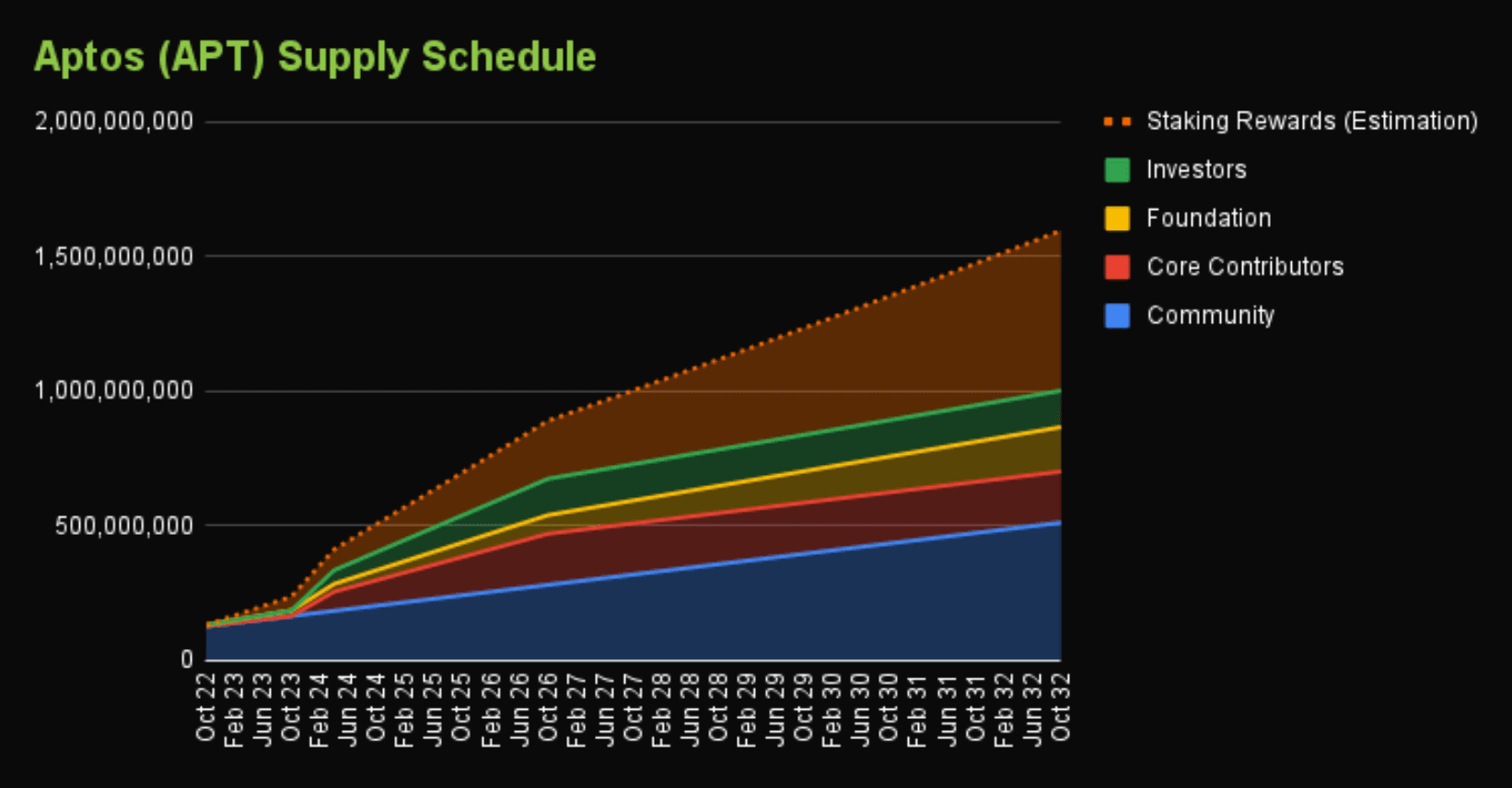
About 1/16th of the tokens allocated to core contributors and investors unlock 18 months after the mainnet launch, while the rest will unlock on the four-year anniversary of the mainnet launch.
The initial supply of APT is not fixed. The validators who stake APT to secure the network are rewarded with newly minted APT tokens, which increase the supply of APT, while the protocol burns the transaction fees, decreasing the supply of APT tokens. All rewards and related mechanisms are modifiable with on-chain governance.
As for Aptos price, we only have about a year of price history to analyze. The token came onto the market with a cost of just under $14, instantly dropping significantly as early investors took profit. Price then increased as retail investors started piling in, increasing the token price to its all-time-high of $18.42 in February of 2023. The price has been steadily decreasing along with the broader crypto market but has started seeing renewed interest as we approach 2024.
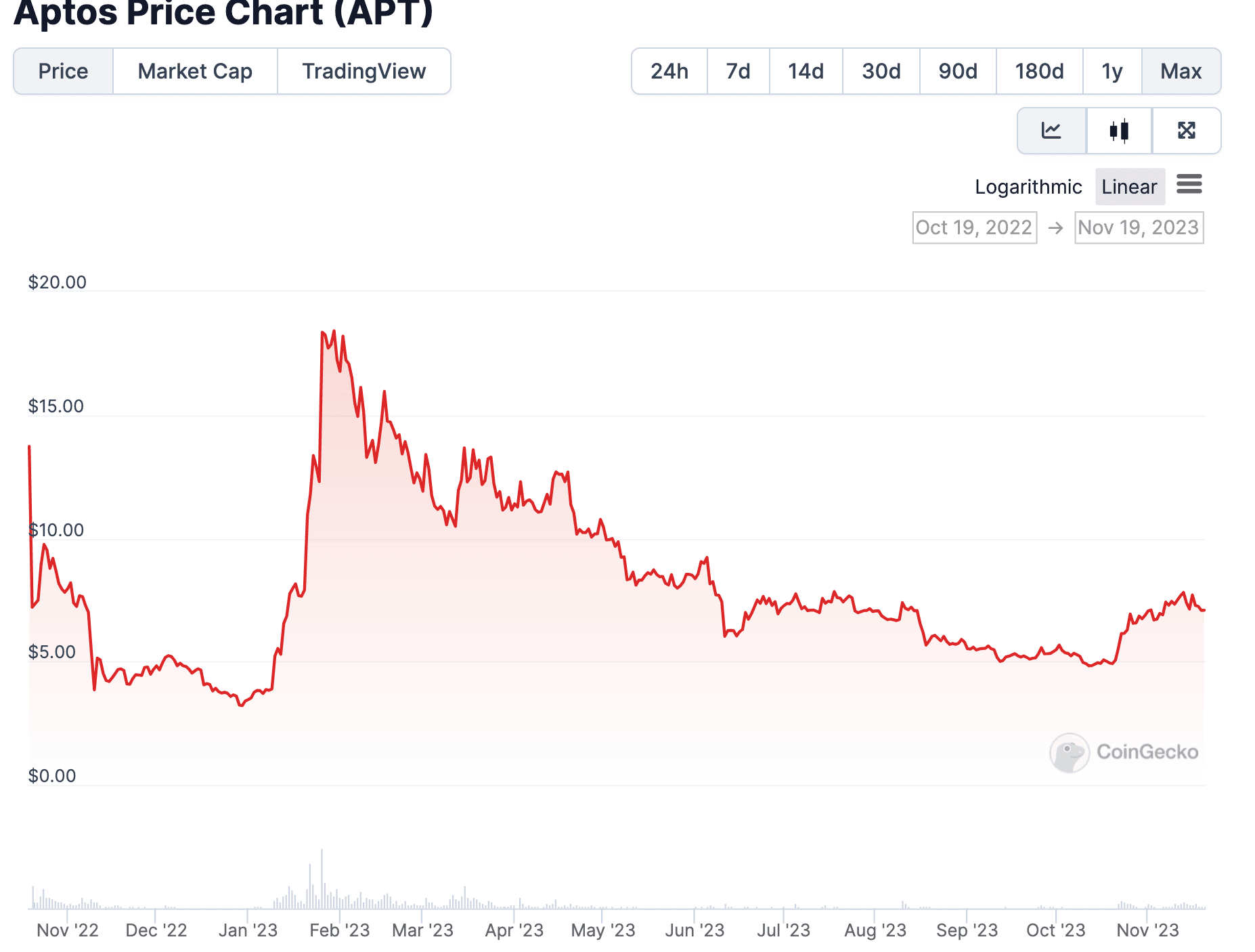
Aptos Network Statistics
There are 117 active validators on the Aptos network at the time of writing the review, staking about 850 million APT between them. The initial APT supply of 1 billion is up by about 66 million APT, which means the validators are earning more rewards than the protocol is burning in fees, inflating APT supply. In contrast, the Ethereum network boasts about 800,000 active validators and more than 28M ETH staked in the network in November 2023.
Where to Buy Aptos
There was a lot of excitement generated prior to the Aptos launch, resulting in widespread support for the APT token. Aptos can be purchased on popular exchanges such as Binance, OKX, Bitget, Bybit, Coinbase, Kraken and others.
The Aptos Ecosystem
The Aptos ecosystem is poised to be diverse and dynamic, owing to the blockchain's innovative features. Aptos, with its emphasis on scalability, security, and the Move programming language, offers a fertile ground for developing various types of Dapps. 1M+ active accounts access the growing Dapp ecosystem of Aptos. Here are the Dapps that pack some of the highest TVL (based on DeFiLlama data) in Aptos in each category:
- Thala - A Move language-powered DeFi protocol enabling borrowing an over-collateralized stablecoin on the Aptos blockchain.
- LiquidSwap – It was the first AMM on Aptos.
- Amnis Finance – A Liquid staking protocol.
- Aries Markets – It is a decentralized margin trading protocol on Aptos.
- Merkle Trade – A Perp DEX offering high leverage on a variety of asset pairs.
- Mole – A DeFi protocol providing leveraged yield farming, hedge fund and savings.
- BlueMove Staking – An NFT marketplace
Aptos Review Parting Thoughts
In concluding our deep dive into the Aptos network, it's evident that Aptos represents a significant stride in blockchain innovation. From its whitepaper to practical implementations, Aptos stands out for its scalability, security, and the unique capabilities of the Move programming language. The network's design, focusing on high transaction throughput and efficiency, positions it as a formidable contender in the blockchain space.
Comparing Aptos with Ethereum, especially regarding tokenomics, network statistics, and hardware requirements, underscores Aptos’s commitment to scalability and performance. While Ethereum 2.0 has made leaps in scalability, energy efficiency, and decentralization, Aptos’s novel parallel processing, key rotation, and transaction transparency offer a distinct architectural advantage.
However, Aptos is not alone in its ambition to leverage the Move language. Networks like the Sui Network also utilize Move, albeit with different implementations and focuses. Sui, with its emphasis on customizable digital assets, presents a different take on Move's capabilities. This diversity in application highlights the flexibility and potential of the Move language in shaping the future of decentralized technologies.
As the blockchain landscape continues to evolve, networks like Aptos are pivotal in pushing the boundaries of what's possible. Aptos, with its robust architecture and growing ecosystem, is well-positioned to be a key player in the next generation of blockchain platforms, promising to drive innovation and adoption in various sectors.
However, it is also worth noting that the project has fallen under intense scrutiny in the industry, with many crypto enthusiasts feeling that Aptos is nothing more than a “VC hype project" only aiming to make money and pad the bank accounts of founders and investors. The Silicon Valley origins and early investment rounds lend some credibility to these opinions, but it is up to each user to decide for themselves if this blockchain with origins dating back to Facebook is authentic or simply a way to make money.
Enjoyed this content? If you want to hear more from us and get up-to-the-minute updates and behind-the-scenes content, feel free to check out our socials channels.
Frequently Asked Questions
Aptos Network's standout features include its high transaction throughput and scalability, underpinned by a unique consensus mechanism based on Byzantine Fault Tolerance. The network utilizes the Move programming language, designed for secure and flexible smart contract development. Additionally, Aptos emphasizes user safety and efficient network management, alongside features like parallel execution for faster processing and a modular architecture for easy upgrades and adaptability.
The Move programming language, developed for the Aptos blockchain, is distinguished by its emphasis on safety and resource-centric approach. Inspired by Rust, it incorporates concepts like linear types to make explicit data ownership and manipulation. Move is designed to prevent common vulnerabilities like double-spending and ensures resources, like digital assets, are handled securely. Its resource-oriented model provides a solid foundation for building secure and complex decentralized applications.
Parallel execution in the context of blockchain technology, as implemented by Aptos, refers to the ability to process multiple transactions simultaneously, rather than sequentially. This approach significantly enhances the transaction processing speed and overall efficiency of the network. By enabling parallel execution, Aptos can handle a higher volume of transactions, making it well-suited for applications that demand high throughput and scalability.
Disclaimer: These are the writer’s opinions and should not be considered investment advice. Readers should do their own research.


